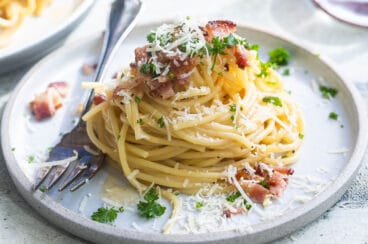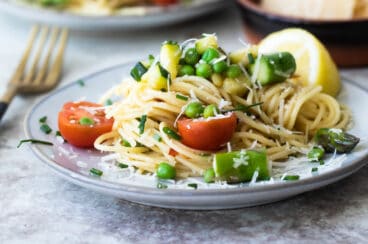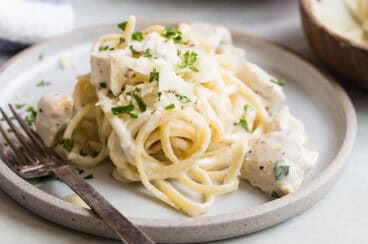This post may contain affiliate links. For more information, please see our affiliate policy.
Classic Cacio e Pepe is a three-ingredient miracle made with pasta, Pecorino Romano, and black pepper. Learn my secret to achieving a silky, restaurant-worthy sauce each and every time.

You’ll love this Cacio e Pepe Recipe
The secret to incredible Cacio e Pepe is using the starchy pasta water you get from cooking the pasta. Here, it does double duty: first, to cook the black pepper in the skillet, and second, to transform Pecorino cheese into a silky, clinging sauce.
We made versions of this in culinary school, and as a classically trained chef, I’ve prepared plenty of classical French and Italian recipes. Some of the best dishes are the simplest.
Some people like to add butter for extra richness. It’s not traditional, but it’s delicious, so I explain it in the recipe card.
Table of Contents
What is Cacio e Pepe?
Cacio e Pepe (KAH-chee-oh eh PEH-pay) is a simple Italian pasta dish made with just 3 ingredients: pasta, black pepper, and Pecorino Romano cheese. “Cacio” means cheese and “pepe” means pepper, so this translates to “cheese and pepper” pasta.
Cacio e Pepe works because of the high-starch pasta watered you used to cook the spaghetti. This simple, clever pasta dish is from the Lazio region of Italy and may have originated in Rome, the capital of Lazio.
Cacio e Pepe Pasta Ingredients

At a Glance: Here is a quick snapshot of what ingredients are in this recipe.
Please see the recipe card below for specific quantities.
- Black Pepper: Coarsely ground pepper is best for this dish. Freshly grind whole black peppercorns using a pepper mill, mortar and pestle, or crush using a meat tenderizer. If you only have finely ground on hand. Use less and adjust to taste.
- Spaghetti: Cacio e pepe uses spaghetti or any long-cut pasta, such as the traditional pici, or bucatini, tonnarelli, linguine, or fettuccine.
- Pecorino Romano cheese: Ideally, start with a block of Pecorino and use a KitchenAid Gourmet Box Grater or pulse in one of my favorite mini or full-sized food processors to shred it yourself. Pre-shredded or pre-grated cheese can contain ingredients that prevent the cheese from melting as smoothly as it does fresh from the brick. Pecorino is a sheep’s milk cheese that tastes a tiny bit sharper than Parmesan. Parmigiano-Reggiano can work here too, in a pinch.
- Butter: While not traditional in this Roman dish, many enjoy the added taste of butter. Melt 1 tablespoon butter in the skillet before adding pepper in step 2. Add an additional tablespoon in step 6 along with the pasta.
How to make Cacio e Pepe
- Bring a large pot of water and 1 tablespoon of salt to a boil. Add spaghetti and cook until 2 to 3 minutes before indicated al dente time, about 8 minutes.

- While the pasta is cooking, in a large skillet over medium to medium-high heat, add ¼ teaspoon fresh coarsely ground black pepper. Cook until pepper is fragrant and begins to toast, about 30 seconds to 1 minute.

- Add a ladle of pasta water (about 4 to 6 ounces) to the skillet with the pepper. Reduce heat and simmer.

- Using tongs, transfer pasta from the pot to the skillet, reserving pasta water. Toss with pepper mixture until pasta is al dente, about 2 to 3 minutes, adding more pasta water if pan becomes dry.

- In a small bowl, combine Pecorino with enough pasta water to form a thick paste. Add Pecorino paste to pasta and use tongs to combine.

- Continue to toss pasta until sauce is creamy and thick, adding more pasta water if needed. Serve with additional grated Pecorino cheese and pepper.

Spaghetti Cacio e Pepe Tips
- Yield: This recipe makes about 4 cups of Cacio e Pepe, enough for 4 generous 1-cup servings.
- Italian feast: Here is a comprehensive list of all Italian courses in a meal.
- Aperitivo: A glass or spumante, prosecco, or champagne with a small dish of olives or cheese to nibble on. If it’s the summer, a refreshing Aperol Spritz or Paloma Cocktail hits the spot!
- Antipasti: Try Bruschetta on Baguette or build out an antipasto platter for a crowd.
- Primi: This Cacio e Pepe recipe is the PERFECT first course in this menu!
- Secondi: I love a rack of lamb or homemade shrimp scampi for this course.
- Contorni: This hearty dish is served alongside the second such as Eggplant Parmesan.
- Insalata: Try my favorite Caprese Salad, or a crisp classic Caesar Salad with homemade Caesar salad dressing and croutons.
- Formaggi e frutta: Pass a plate of regional cheese and seasonal fruits that complement the flavors of the cheese.
- Dolce: A pizzelle Italian cookie (you’ll want to pick up one of the best pizzelle makers you can buy) or tiramisu will round out the meal. To do it up in true Italian style, don’t forget to brew an Italian coffee (the caffe).
- Digestivo: Make sure to finish with a digestivo like Limoncello or grappa.
How to store Cacio e Pepe
This dish is best enjoyed the day it is made, but leftovers can be stored covered in an airtight container in the refrigerator for up to 4 days. Reheat in the microwave with a splash of water.
Make ahead
Enjoy immediately. This is a humble pasta dish that’s made on the fly and meant to be eaten right away. No make ahead tips, here, unless you want to make your own pasta.

Frequently Asked Questions
While both are traditional Roman pasta dishes, Carbonara‘s creaminess comes from an emulsion of egg, guanciale or pancetta, and cheese. Cacio e Pepe uses starchy pasta water, black pepper, and cheese instead.
It’s pronounced KAH-chee-oh eh PEH-pay.
This simple pasta dish originated in Rome. According to legend, Cacio e Pepe was also a favorite of the Roman Empire’s first emperor, Augustus.
More pasta recipes
Italian Recipes
Spaghetti Carbonara
Italian Recipes
Pasta Puttanesca
Italian Recipes
Pasta Primavera
Italian Recipes
One Pot Chicken Alfredo
Join Us

Spaghetti Cacio e Pepe
Ingredients
- Salt and freshly ground black pepper coursely ground (see note 1)
- 8 ounces spaghetti (see note 2)
- 1/2 cup Pecorino Romano cheese freshly grated, about 2 ounces (see note 3)
Instructions
- Bring a large pot of water and 1 tablespoon of salt to a boil. Add spaghetti and cook until 2 to 3 minutes before indicated al dente time, about 8 minutes.
- While the pasta is cooking, in a large skillet over medium to medium-high heat, add ¼ teaspoon fresh coarsely ground black pepper. Cook until pepper is fragrant and begins to toast, about 30 seconds to 1 minute.
- Add a ladle of pasta water (about 4 to 6 ounces) to the skillet with the pepper. Reduce heat and simmer.
- Using tongs, transfer pasta from the pot to the skillet, reserving pasta water. Toss with pepper mixture until pasta is al dente, about 2 to 3 minutes, adding more pasta water if pan becomes dry.
- In a small bowl, combine Pecorino with enough pasta water to form a thick paste. Add Pecorino paste to pasta and use tongs to combine.
- Continue to toss pasta until sauce is creamy and thick, adding more pasta water if needed. Serve with additional grated Pecorino cheese and pepper.
Notes
- Black Pepper: Coarsely ground pepper is best for this dish. Freshly grind whole black peppercorns using a pepper mill, mortar and pestle, or crush using a meat tenderizer. If you only have finely ground on hand. Use less and adjust to taste.
- Spaghetti: Or any long-cut pasta, such as the traditional pici, or bucatini, tonnarelli, linguine, or fettuccine.
- Pecorino cheese: Ideally, start with a block of Pecorino and use a box grater or pulse in a food processor to shred it yourself. Pre-shredded or pre-grated cheese can contain ingredients that prevent the cheese from melting as smoothly as it does fresh from the brick.
- Butter: While not traditional in this Roman dish, many enjoy the added taste of butter. Melt 1 tablespoon butter in the skillet before adding pepper in step 2. Add an additional tablespoon in step 6 along with the pasta.
- Yield: This recipe makes about 4 cups of pasta, enough for 4 servings, 1 cup each.
- Storage: This dish is best enjoyed the day it is made, but leftovers can be stored covered in an airtight container in the refrigerator for up to 4 days. Reheat in the microwave with a splash of water.
Nutrition
Meggan Hill is a classically-trained chef and professional writer. Her meticulously-tested recipes and detailed tutorials bring confidence and success to home cooks everywhere. Meggan has been featured on NPR, HuffPost, FoxNews, LA Times, and more.



